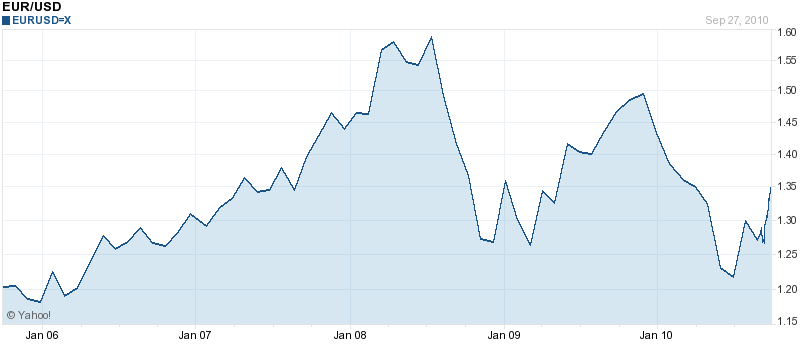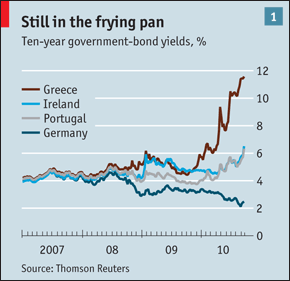September 29th 2010
Bullish on the Euro?
Wouldn’t life just be a little easier if the EUR/USD, the most important forex pair and bellwether of currency markets, could simply pick a direction and stick to it. It dove during the financial crisis, only to surge during the apparent recovery phase, fell during the sovereign debt crisis, and rose during the paradigm shift, then fell as risk appetite waned, only to rise again in September, en route to a 5-month high.

There are a handful of factors which currently underlie the Euro’s strength, which can all generally be explained by the fact that risk is “on” at the moment, and the markets are moving away from so-called safe haven currencies and back towards growth investments. Of course that could change tomorrow (or even 5 minutes from now!), but at the moment, risk appetite is high and the Euro symbolizes risk. Never mind how ironic it is, that growth in the EU is projected at 1.8% for the year while Rest of World (ROW) GDP will probably top 5%. All that matters is compared to the Dollar (and Yen, Pound, Franc to a lesser extent) the Euro is perceived as the currency of risk.
The Euro’s cause is also helped by the ongoing “currency wars,” which heated up last week with Japan’s entry into the game. Basically, Central Banks around the world are now competing with each other to devalue their currencies. In contrast, the European Central Bank (ECB) has decided to remain on the sidelines (in favor of fiscal austerity), which is forcing the Euro up (or rather all other currencies down). To make matters even worse, “The U.S. Federal Reserve indicated this summer that it may ease monetary policy further… often seen as printing money to pump up the economy.” As a result, “The euro looks set to keep on climbing in a trend that looks increasingly entrenched.”
There are certainly those that argue that the Euro’s recent surge reflects renewed confidence in the Eurozone economy and prospects for resolving the EU debt crisis. After all, most Euro members will reduce their budget deficits in 2010 and auctions of new bonds are once again oversubscribed. On the other hand, interest rates for the PIGS (Portugal, Italy, Greece, and Spain) have risen to multi-year highs, as investors are finally trying to make a serious effort at pricing the possibility of default.

In addition, the credit markets in the EU are barely functioning, and large institutions remain dependent on the ECB’s credit facilities for financing. Finally, it shouldn’t be forgotten that the only reason crisis was due to the massive support (€140 Billion) extended to Greece. When this program expires in less than three years, the fiscal problems of Greece (and the other PIGS) will be exposed once again, and a new (stopgap) solution will need to be proposed.
As every analyst has pointed out, none of the EU’s fiscal problems have been solved. EU members have certainly proven adept at resolving acute crises and the ECB certainly deserves credit for keeping credit markets functioning, but none has proposed a viable solution for repairing of member countries’ fiscal and economic health. Currency devaluation is impossible. Sovereign default is being prevented. That leaves wage cuts and increased productivity as the only two paths to equilibrium. The former could be accomplished through inflation, but the ECB seems reluctant to allow this to happen.
For better or worse, the EU seems to have pushed these problems down the road, and if all goes according to plan, they won’t need to be revisited for 2-3 years. For now, then, the Euro is probably safe, and may even thrive. Short positions in the Euro are being unwound with furious speed and data indicate that there is still plenty of scope for further unwinding. Inflation remains subdued, economic growth is stable, and the ECB so far hasn’t voiced any disapproval of the Euro’s rise. While I promote this bullishness with the caveat that “traders have shown a willingness to smack the euro lower from time to time on the slightest news or rumor of downgrades to euro-zone sovereign or bank ratings,” the general Euro trend is now unquestionably UP.




September 29th, 2010 at 6:54 pm
I think the bulish of the euro will soon reach to an end and the drop will be so big that some will loose their accounts. the euro is already high enough for these hard times. we`ll see what`s gonna happen.
July 11th, 2011 at 4:46 am
I traded eurusd, and I think this blogpost could give me a big picture of the euro factor that can help me to figure out where it’s heading. thnx